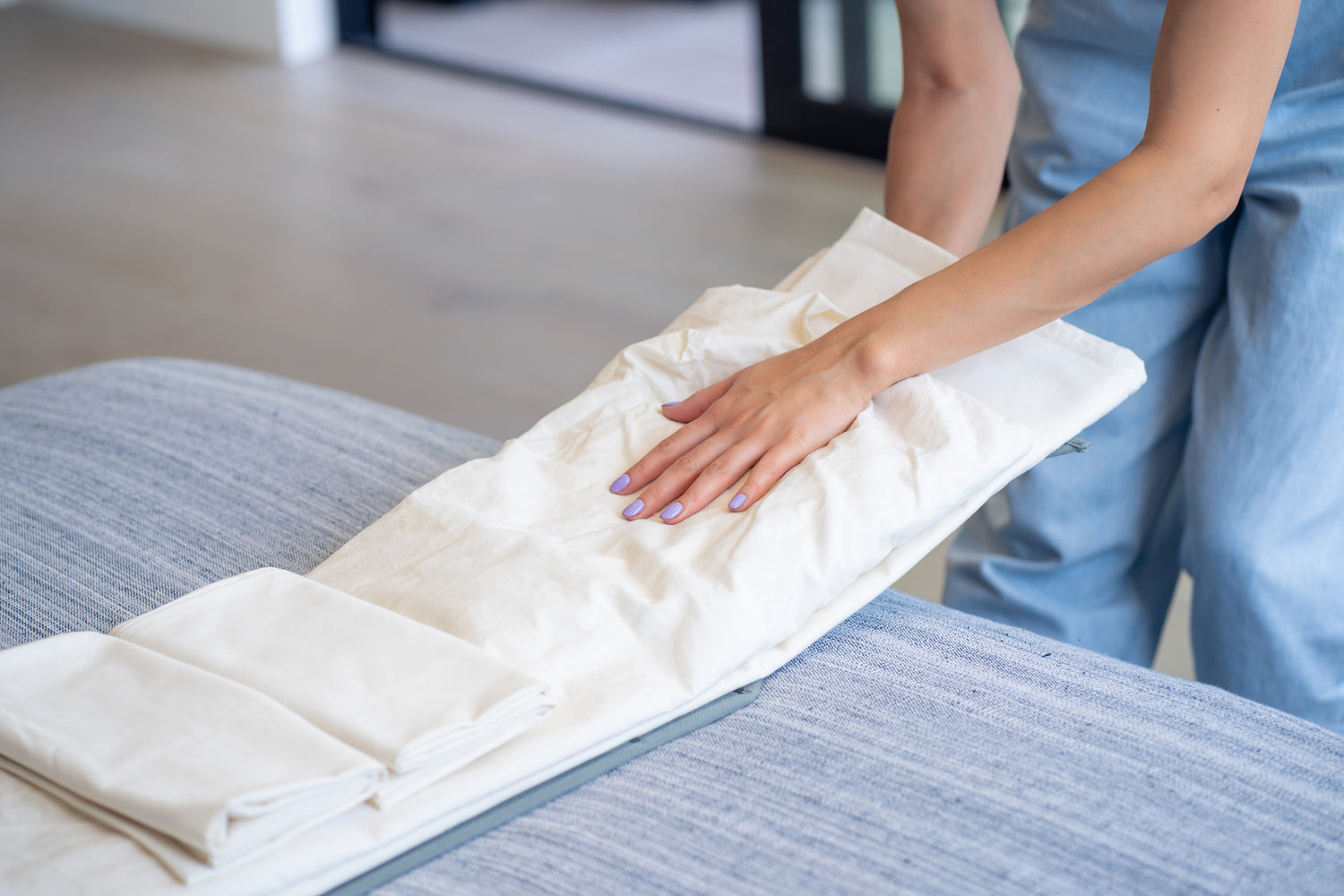How to Choose the Perfect Set of Sheets
With all the options, it can be hard choosing the perfect pair of sheets. Luckily, we've done all the research to figure out what makes a great sheet set stand out from all the others.
We'll go over:
• Thread Counts
• Fabrics
• Different Types of Cotton - and what they really mean
• How to pick the best sheet for your particular bed and lifestyle
All About the Thread Count
You've probably heard all about how high thread counts make for the perfect sheets. But what exactly are thread counts, and why are they important?
Facts About Thread Counts
1. Thread count refers to the number of vertical and horizontal threads per square inch
2. Typically, higher = better. The more threads, the softer the sheet
3. Higher thread count linens typically age well, and even gain softness over time
4. Good sheets range from 200 to 800 thread count
While thread count is important, it’s not the only thing to consider. A lower count in combed cotton from a well regarded brand can go a long way. They likely have very high certification standards for finishing processes.
Choosing the Right Fabric
When choosing the perfect set of sheets, it’s important to understand the fabrics of which they are made. This will help you make a wise choice so you end up with the perfect pair of sheets!
There are several things to consider:
1. How cool or warm do you want to feel in bed?
During winter, you may want flannel sheets or linen sets. You may opt for a cooler sateen sheet for Summer or warmer months.
2. The kinds of sheets you already have
Many people like to have at least 1 or 2 sets of cotton percale or sateen sheets (more on this later!).
3. Budget
With research and using reputable brands, you can get a great pair of sheets, even on a budget. Even if you aren't worried about the cost, you'll want to make sure you still get the most high quality purchase for your money
The Different Types of Cotton
Reading a label on a sheet set can be downright confusing. There are many different types of cotton. It’s important to know what kind you prefer, so you can choose the best pair of sheets.
Fiber Differences: Extra long vs. Short
The longer the cotton fiber, the softer and more luxurious the cotton is. Longer staples are typically more expensive but much softer and durable over time.
Types of Cotton:
Egyptian
This is the highest quality cotton that you can find. Egyptian cotton boasts a smooth finish, resistance to pilling, and has incredible durability over time. Egyptian cotton is made with extra long cotton fibers – the longest cotton fiber available, making it a great choice for both luxury and longevity.
Pima
Pima, also called Supima®, the trademarked name for American Pima cotton, is also a very high quality cotton. It’s also made with long staple fibers, making the cotton durable, luxurious, and soft. This cotton is still very high quality but is less expensive than Egyptian cotton.
Upland
This short-staple cotton is the most common cotton. Labels that tote “100 percent cotton” are usually Upland. These are durable and soft, but not nearly as much as the longer-staple cottons. This type is a lot cheaper, and the quality is not as high as Egyptian or Pima.
Flannel
Flannel is a kind of cotton that has been shredded. From this, individual yarns are shaved to release the fibers, resulting in a much fuzzier and thicker feel. The weave of flannel also makes it soft and cozy, making it perfect for cold weather and sleepers who run cold. When we say flannel, we don’t just mean lumber-jack style (though you will feel warm and cozy!). Flannel fabric comes in many different colors, patterns, and styles.
Jersey
Jersey cotton is likely what your favorite stretchy t-shirt is made out of. This type of cotton is low cost, soft, and comfortable. However, they aren’t very durable and they are pliable with age, meaning they’ll start stretching out over time and after being washed.
Microfiber vs. Cotton
Microfiber is actually very different from cotton! Microfiber refers to fabric that is composed of the fine fibers of polyester. They are affordable and soft, and they are more resistant to pilling compared to regular polyester fabric.
However, there are some definite cons to microfiber:
1. Polyester is much less breathable
2. It is not a great choice for those with sensitive skin or those who run hotter at night
3. Flipping your pillowcase to the cool side just wont happen with microfiber - there isn't one
4. Not nearly as durable as cotton
Thought microfiber can feel luxurious at first touch, it is a much cheaper - both in quality as well as price - than cotton.
Weave Types
Weave types can be confusing. Oftentimes, the weave of the fabric won’t be a big part of your decision making process when it comes to finding the perfect set of sheets. However, you may have a preference on the weave, so it never hurts to understand what the label is actually saying! Here are a few terms to know:
1. Sateen:
This cotton has a satin weave that produces a luxurious feel. However, it is less durable than a tighter weave.
2. Combed Cotton:
This cotton has been combed to remove short fibers, leaving only the longer, more luxurious ones. This results in an amazingly soft and strong fabric.
3. Percale:
This fabric is plain, durable, and crisp, with a thread count of at least 180.
Making the Right Choice for Your Bedroom & Lifestyle
It’s important to consider the size of your mattress (including depth), the decor/color scheme you’re going with, and any lifestyle and sustainability considerations you may have.
Fit:
Before shopping, it’s important to know the depth of your mattress – including your mattress topping. Most regular sheets will fit most mattresses, but if your mattress is super thick, you’ll want to make sure that you get sheets that fit. Most sheet brands use depth in their measurements – but not all.
Bonus Tip: Make sure you go with a brand who has an easy and flexible return policy in case the bottom sheet does not fit properly.
Keep in mind these tips when look at depth:
1. The right fitted sheet will be taut on your mattress
2. You should have to pull a bit to make the sheet get into place. You shouldn’t have to play tug of war, but rather just a gentle pull out of the pocket
3. Fitted sheets should have 2 to 3 inches more pocket depth than your mattress (with the topper) has - including the topper
4. This allows excess slack to tuck under the corners, keeping your fitted sheet into place
Colors and Patterns
A great set of sheets can really add to your home decor.
Here are some tips to keep in mind when selecting your pattern or color:
1. Brightly hued sheets can be harder to care for than white
2. White sheets can be a great choice since they can be bleached or cleaned with OxiClean
3. Stains from sweat, menstruation, kids and more are harder to remove on brightly hued sheets. Be honest to yourself, your bedtime patterns and likelihood to stain
What about "eco-friendly" or organic bedding?
If you are concerned with sustainability and the environmental impact of your purchases, look for sheets made with organic cotton or those that have environmental, fair labor and other certifications.
Taking Care of Your Sheets
Buying the best sheets is an investment. Luxury sheets really are an investment – and not just financially. They’re a great form of self-care, and when you buy them, you’re investing in your sleep, your health, and your comfort.
Seems like a small price to pay for a great night’s sleep! Nonetheless, you’ll want to do everything you can to take care of your investment, so that they last you for years to come.
Folding and Storing Your Sheets Properly
One way to really care for your sheets is to fold them and store them properly. Folding can be an absolute nightmare - especially for fitted sheets!
LinenMate is a five step patented folding, storage, and identification solution for your bed linens. This amazing system helps you fold even the trickiest bottom sheets. You can zip it and store it away, keeping out germs, dirt, pollen, and more.
This system will help make sure that your perfect sheet set stays nice and clean to last you for years to come. You can not only make sure your sheets are cared for and organized, but you’ll have a Pinterest-worthy linen closet at the same time!
See more about LinenMate here: https://linktr.ee/linenmate
Finding the perfect sheet set doesn't have to be complicated!
Make sure you consider:
• Fabric Type
• Weave Type
• Sleeping Habits
• Your Home Decor
• Sustainability
• Durability & Longevity
• Temperature / Climate
Now that you know the different types of fabrics and weaves that your sheets are made out of, you will be better prepared to find your next favorite pair of sheets when strolling the aisles or shopping online!





